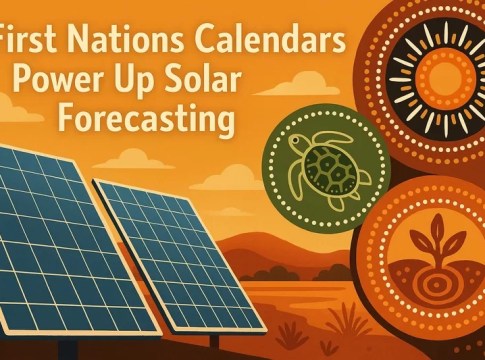Ancient Wisdom Meets AI: First Nations Calendars Power Up Solar Forecasting in World-First Study
In the sun-drenched heart of Australia’s Northern Territory, where the desert blooms in cycles understood long before the Gregorian calendar arrived, a quiet revolution in renewable energy is underway.
Charles Darwin University has announced a world-first study blending Indigenous seasonal knowledge with cutting-edge artificial intelligence to significantly improve the forecasting of solar power generation. The research published in the IEEE Open Journal of the Computer Society offers a surprising and promising twist in the global race to stabilise renewable energy supply.
At the heart of the project is a simple but profound idea: the sun has been watched, understood, and lived with for tens of thousands of years by Australia’s First Nations people. Why not let that wisdom guide solar forecasting?
Advertisement:
Beyond the Weather App: Solar’s Reliability Problem
While solar energy is one of the cornerstones of the world’s push toward renewables, it has a glaring Achilles’ heel: unpredictability. Cloud cover, dust, humidity, and heat haze all mess with the amount of power a solar panel can soak up. Even the most sophisticated meteorological tools often fall short.
To tackle this, researchers at CDU turned to deep learning — an advanced artificial intelligence technique — and trained a model using not just modern data, but First Nations seasonal calendars including those of the Tiwi, Gulumoerrgin (Larrakia), Kunwinjku and Ngurrungurrudjba peoples.
These calendars, rooted in close observation of plant flowering, animal migrations, and weather cues, reflect ecological rhythms specific to each region — and they’re far more nuanced than the four tidy seasons most Australians are used to.
The model was also cross-referenced with the Red Centre calendar and solar data from the Desert Knowledge Australia Solar Centre in Alice Springs, a site already familiar to energy researchers as a solar testbed.
The result? A model with an error rate less than half that of existing forecasting methods used by industry.
Advertisement:
“It’s All in the Seasons” — Ancient Knowledge, New Tools
Bundjalung PhD student and co-author Luke Hamlin, one of the driving forces behind the study, said that the depth of environmental knowledge embedded in First Nations calendars offered something AI couldn’t learn from numbers alone.
“Incorporating First Nations seasonal knowledge into solar power generation predictions can significantly enhance accuracy by aligning forecasts with natural cycles that have been observed and understood for thousands of years,” Mr Hamlin said.
He pointed out that while standard meteorological models rely on satellite data and pattern recognition, Indigenous calendars track events like the blooming of a specific flower, or the arrival of a bird species — localised phenomena that correlate strongly with shifts in solar conditions.
“These seasonal insights are deeply rooted in ecological cues,” he explained. “That means they’re uniquely capable of identifying subtle regional variations that affect solar panel efficiency.”
Advertisement:
Revolution in the Outback?
For co-authors Associate Professor Bharanidharan Shanmugam and Dr Thuseethan Selvarajah, the breakthrough doesn’t just belong in research papers. It has real-world implications — especially for remote and rural communities where energy stability is vital and conventional forecasting often fails.
“Accurate solar power prediction is challenging,” said Associate Professor Shanmugam. “These challenges hinder the development of a universal prediction model.”
That’s where localised models, built with Indigenous seasonal knowledge, can shine.
“The success of the proposed approach suggests that it could be a valuable tool for advancing solar power generation prediction in rural areas,” said Dr Selvarajah. “In future work, we’ll explore the application of the model to other regions and renewable energy sources.”
Reclaiming Knowledge in a High-Tech World
There’s something beautifully ironic about this development: after centuries of ignoring or marginalising Indigenous knowledge systems, it turns out the future of energy might depend on them. This isn’t just reconciliation — it’s revolution.
By bringing the oldest continuous cultures on Earth into dialogue with the latest AI tools, this research marks a powerful new direction for renewable technology. One that’s smart, sustainable — and long overdue.
The full paper, Conv-Ensemble for Solar Power Prediction with First Nations Seasonal Information, is available via IEEE: Read here.
Advertisement:
Related stories
First Nations perspective on what should happen to native forests when logging ends
19th-Century Ship’s Figurehead of First Nations Woman
National Sorry Day: Remember the Past, Bring the Babies Home
The first “Welcome to Country” ceremony in Australia
First Contact: indigenous Australians & Cook on Endeavour




